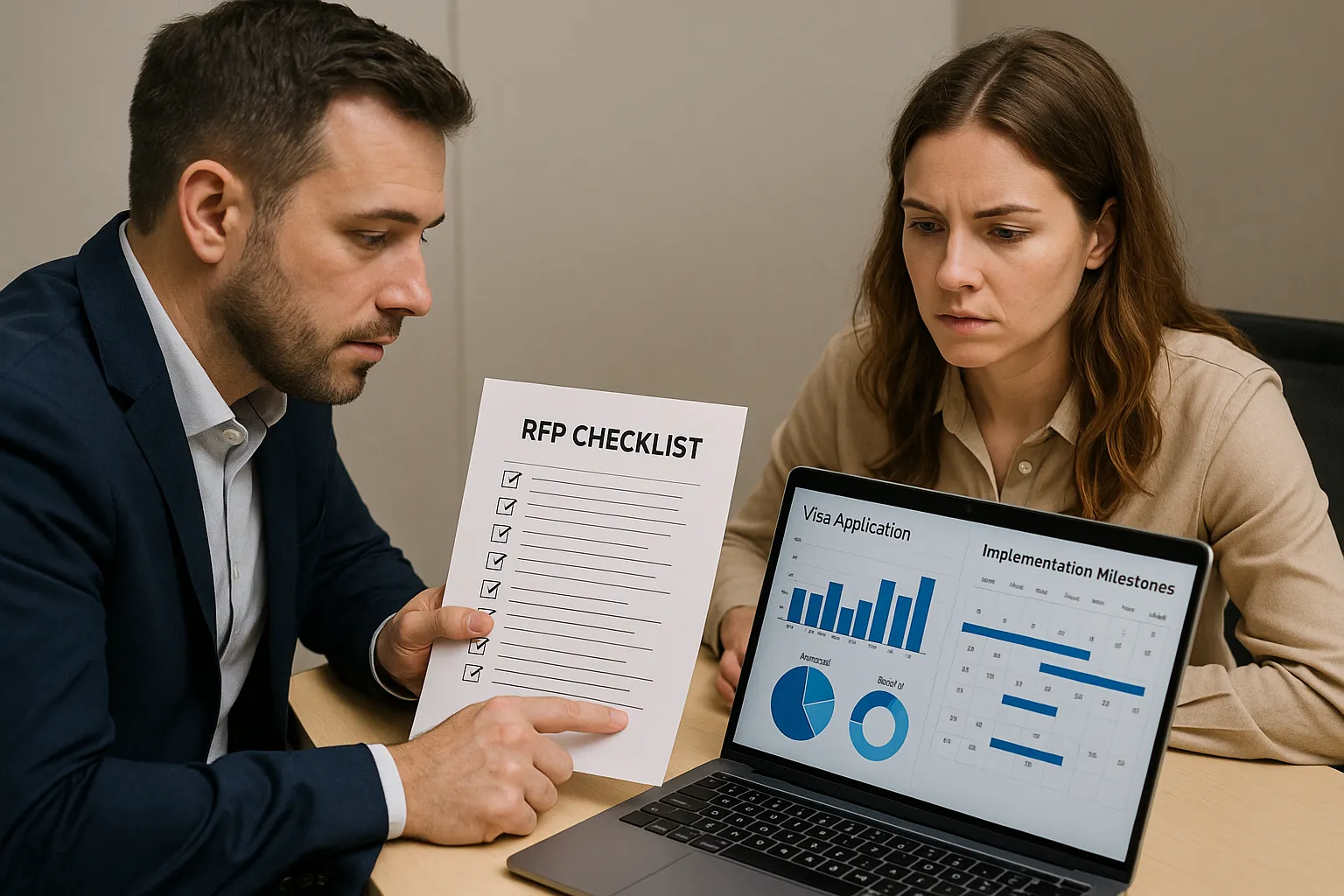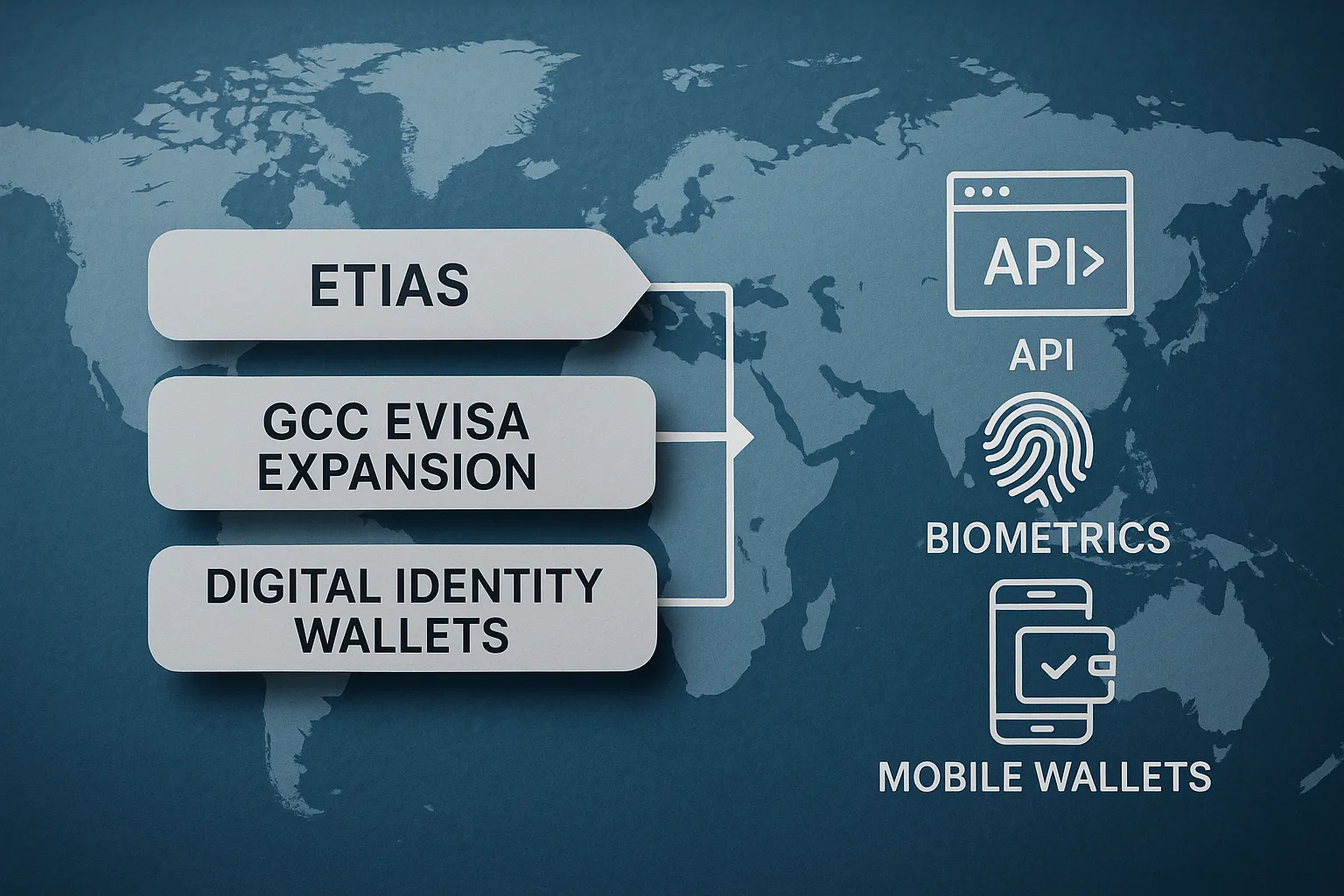RFP Checklist: 15 Questions to Choose the Right Visa Management Platform

Deploying a new visa-management vendor touches revenue, compliance, customer experience, and your engineering roadmap all at once. A well-structured Request for Proposal (RFP) helps you surface deal-breakers early and compare providers on an apples-to-apples basis. Use the 15 questions below as a ready-made checklist to shortlist the right platform—and avoid months of re-work later.

Why this checklist matters
• Global regulators are rolling out new digital authorisations (ETIAS, UK ETA, GCC eVisas) at record speed.
• Travellers expect in-flow guidance—booking abandonment doubles when visa steps feel risky or confusing.
• Airlines and OTAs that embed visa services capture up to 12 % extra ancillary revenue, according to SimpleVisa’s 2024 upsell study.
Choosing the wrong partner means missed revenue, denied boardings, and compliance fines. These 15 questions cover the capabilities that separate a scalable visa management platform from a glorified form-filling tool.
| Category | Questions to Ask |
|---|---|
| Coverage & Accuracy | 1–3 |
| Integration & UX | 4–6 |
| Security & Compliance | 7–9 |
| Commercial Model & ROI | 10–11 |
| Operations & Support | 12–13 |
| Future-Readiness | 14–15 |
Coverage & Accuracy
-
Which nationalities, destinations, and document types do you support today—and how often is the rule engine updated?
Look for daily or real-time updates, not quarterly batch jobs. Ask for evidence: changelogs, API version history, or links to government bulletins. -
Do you guarantee accuracy and carry liability for denied boardings?
Some vendors indemnify partners up to a fixed amount; others only provide “best-effort” data. Clarify the fine print before your CFO asks. -
How is application success rate measured and reported?
A high-90s approval rate is achievable with document pre-validation and automated data checks. Request live dashboard samples or anonymised benchmarks.
Integration & UX
-
What integration models are available (API, SDK, no-code widget, white-label portal)?
Match options to your engineering bandwidth. Our guide “API vs. White-Label App: Which Visa Integration Model Suits You?” breaks down trade-offs in detail. -
Can the workflow be embedded natively inside the booking path without redirecting users?
Every extra click costs conversions. Ask for mobile demos and check Lighthouse scores. -
How do you handle multi-passenger, multi-segment, and post-booking scenarios?
Family itineraries, cruise shore trips, or split PNRs create edge cases many vendors overlook. Demand concrete user flows, not promises.
Security & Compliance
-
Which security features are built in end-to-end?
Encryption at rest/in transit, MFA, biometric liveness checks, and audit logs are table stakes. If a vendor hesitates, revisit “Top 8 Security Features to Demand in Any Electronic Visa Solution.” -
What certifications and audits do you hold?
ISO 27001, SOC 2 Type II, PCI-DSS (for payments) and GDPR readiness should be non-negotiable for global brands handling PII. -
How is traveller data stored, tokenised, and deleted?
Confirm data-retention periods, right-to-erasure workflows, and sub-processor lists. Penalties for mishandled personal data now exceed the revenue of some entire flight routes.
Commercial Model & ROI
-
Which revenue-sharing or pricing models are offered?
Flat referral fees, percentage commission, dynamic mark-ups, and SaaS licences each suit different strategies. Review “7 Revenue-Sharing Models for Online Visa Processing Partners” for benchmarks. -
What uplift in ancillary revenue and booking conversion can you prove?
Ask for case studies with quantified results (e.g., +6 % attach rate, −30 % support tickets). Tie projected ROI to your own booking volumes.
Operations & Support
-
What SLA do you provide for API uptime and end-user support?
Aim for ≥99.9 % availability and 24/7 traveller chat or email support—especially if you sell long-haul red-eyes across time zones. -
How do you train our frontline teams on visa rules and platform use?
Look for structured programs like the one detailed in “How to Train Customer Support Teams on eVisa Rules in One Week,” including playbooks, certification, and refresher modules.
Future-Readiness
-
How do you roadmap for upcoming regulations (ETIAS, EES, new ETAs, digital wallets)?
Vendors should participate in industry working groups or pilot programs and publish proactive timelines. -
Can your platform ingest or issue digital identity credentials and integrate with biometric corridors?
Border tech is moving toward smart gates and mobile passports. A future-proof vendor will already expose standards-based APIs for verifiable credentials.

Putting the checklist to work: next steps
- Copy these 15 questions into your RFP template.
- Weight each answer based on your priorities (coverage, speed-to-market, revenue).
- Schedule demo calls and insist on a live sandbox walkthrough—SimpleVisa’s sandbox even lets you test webhook flows and retrieve sample PDF visas in minutes.
Need a deeper dive? Our long-form guide “Travel Document Automation 101: Choosing the Right Platform for Your Agency” walks through build-vs-buy maths, red-flag patterns, and a 21-day pilot plan.
Frequently Asked Questions
Do all travel brands need a full API integration? No. APIs offer maximum control but a white-label portal or embeddable widget can go live in days and still drive ancillary revenue.
How long does a typical implementation take? SimpleVisa clients with an agile tech stack launch in 30–60 days for API projects and under a week for no-code widgets.
What if visa rules change after go-live? Leading platforms push real-time rule updates automatically. Your booking flow shows the new requirements instantly without code changes on your side.
Ready to evaluate platforms the smart way?
The checklist above is a great start, but nothing beats seeing a visa management platform in action. Book a 20-minute SimpleVisa demo to get live answers to every RFP question—plus a customised revenue forecast for your brand.
Travel is complicated. Visa compliance shouldn’t be.
Request your demo at simplevisa.com and discover how easy border crossing administration can be.